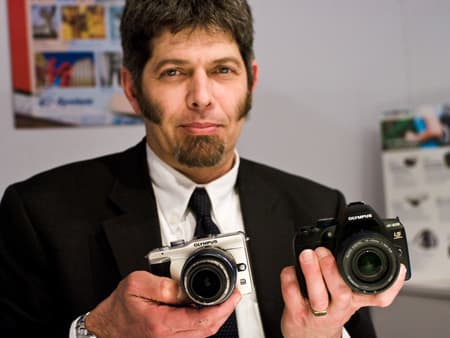The Olympus E system of Four Thirds cameras is likely to be completely mirrorless in two years time, according to Olympus America?s DSLR product manager.
Speaking exclusively to AP editor Damien Demolder and technical editor Angela Nicholson at the PMA convention in Anaheim, Richard S. Pelkowski explained that the electronic technology in the company?s Micro Four Thirds Pen cameras has already surpassed the viewing methods of traditional DSLR models, and that there seems to be no reason to maintain mirrors, ground glass screens, prisms and viewfinder lenses in even the traditionally styled E system SLR cameras.
?I would say that within 24 months the E system will not have a mirror box at all.? Pelkowski said, ?Up until we launched the Pen cameras all manufacturers were doing was fitting a digital sensor in what is ultimately a film camera body ? there was nothing different. But with digital and electronic technology we can make cameras so much smaller.?
Removing the optical viewing path from an E system camera would not only allow Olympus to make size and weight savings, but would also make it easier to include HD movie functionality. With the traditional dual curtain shutter removed as well, Mr Pelkowski said that a fully electronic shutter could be introduced that would make extremely high frames rates such as 20fps possible. ?Soon the AF system in the Pen cameras will be as fast as that in the E system DSLRs so there it will be possible to get just as good AF performance without the mirror system.?
While explaining that the image quality of the E-P2 is just as good as that of the E3, Pelkowski moved to reassure AP readers that the full Four Thirds system would continue to exist. ?We have a great range of lenses for the Four Thirds system, and they?re not going anywhere, but they will be used on smaller and lighter more modern bodies.?
AP was told that 14 million pixels are more than enough for a consumer level camera, and that pixel-counts of 18 million or more are unnecessary. The Micro Four Thirds sensor used by Olympus is big enough as well, and with improved noise control in camera there is no need for the extra space of an APS-C sized chip. ?Using a bigger chip just means your lenses will be bigger,? Mr Pelkowski said.
Read AP’s clarification statement here









